"Nobel Laureate Richard Smalley, a Rice University professor who helped discover buckyballs, the soccer ball-shaped form of carbon, and championed the field of nanotechnology, has died at the age of 62.
Smalley, who had battled cancer, died Friday at M.D. Anderson Cancer Center, Rice University said.
'We will miss Rick's brilliance, commitment, energy, enthusiasm and humanity,' Rice President David Leebron said.
He shared the 1996 Nobel Prize in chemistry with fellow Rice chemist Robert Curl and British chemist Sir Harold Kroto for the discovery of the new form of carbon, which they dubbed buckminsterfullerene - buckyballs for short - because of its resemblance to the geodesic domes designed by Buckminster Fuller."
See my link at left to 'Everything I Know' and Buckminster Fuller. Also, 'Heroes Still', listed under the Essays section, also on the left.
Saturday, October 29, 2005
Friday, October 28, 2005
The Norman Transcript--Typewritten words
"The history of the typewritten word is a lesson in clumsy marketing, society's changing values and America's economic cycles over the past 150 years.
Much of it is on display at Copelin's Office Center, 425 W. Main, St. where old, black typewriter specimens looking more like industrial machines than office appliances squat on glass shelves. Had they been equipped with the memory and storage functions of today's computers, they might well tell us something of their owners and users, long since gone."
Any newspaper named 'The Norman Transcript' has to be good. This is an interesting article about the history of typewriters, with even a mention of fountain pens:
"Ed Copelin, owner of the office supply business for 22 years, said he has been “haphazardly” collecting antique typewriters, adding machines and cash registers for about half that time.
Copelin said he has the fortune of many old friends who donated their office machines over the years. He decided to exhibit the antiquated typewriters “because they’re reflective of the business I’m in.”
He also has an extensive fountain pen collection and hosts a fountain pen show every few years. Collectors use the show to buy, sell and trade writing instruments."
Much of it is on display at Copelin's Office Center, 425 W. Main, St. where old, black typewriter specimens looking more like industrial machines than office appliances squat on glass shelves. Had they been equipped with the memory and storage functions of today's computers, they might well tell us something of their owners and users, long since gone."
Any newspaper named 'The Norman Transcript' has to be good. This is an interesting article about the history of typewriters, with even a mention of fountain pens:
"Ed Copelin, owner of the office supply business for 22 years, said he has been “haphazardly” collecting antique typewriters, adding machines and cash registers for about half that time.
Copelin said he has the fortune of many old friends who donated their office machines over the years. He decided to exhibit the antiquated typewriters “because they’re reflective of the business I’m in.”
He also has an extensive fountain pen collection and hosts a fountain pen show every few years. Collectors use the show to buy, sell and trade writing instruments."
Labels:
typewriter,
writing
Thursday, October 27, 2005
Man's Best Friend Is Pretty Smart
A very interesting article on canine intelligence...even comparing domesticated dogs to wolves...and how that intelligence may differ.
"After a decade studying dogs in their human habitat, Mr. Miklosi and his colleagues have accumulated a body of evidence suggesting that dogs have far greater mental capabilities than scientists had thought. "
"After a decade studying dogs in their human habitat, Mr. Miklosi and his colleagues have accumulated a body of evidence suggesting that dogs have far greater mental capabilities than scientists had thought. "
Labels:
dog,
intelligence
Monday, October 24, 2005
Researchers all but zap ancient death ray myth
"SAN FRANCISCO - It wasn't exactly the ancient siege of Syracuse, but rather a curious quest for scientific validation.
According to sparse historical writings, the Greek mathematician Archimedes torched a fleet of invading Roman ships by reflecting the sun's powerful rays with a mirrored device made of glass or bronze.
More than 2,000 years later, researchers from the Massachusetts Institute of Technology and the University of Arizona set out to recreate Archimedes' fabled death ray Saturday in an experiment sponsored by the Discovery Channel program 'MythBusters.'"
According to sparse historical writings, the Greek mathematician Archimedes torched a fleet of invading Roman ships by reflecting the sun's powerful rays with a mirrored device made of glass or bronze.
More than 2,000 years later, researchers from the Massachusetts Institute of Technology and the University of Arizona set out to recreate Archimedes' fabled death ray Saturday in an experiment sponsored by the Discovery Channel program 'MythBusters.'"
Saturday, October 22, 2005
E-Tutoring Broadens Bounds of Outsourcing
"Oct 22, 5:59 PM (ET)
By NIRMALA GEORGE and MARTHA IRVINE
COCHIN, India (AP) - A few stars are still twinkling in the inky pre-dawn sky when Koyampurath Namitha arrives for work in a quiet suburb of this south Indian city. It's barely 4:30 a.m. when she grabs a cup of coffee and joins more than two dozen colleagues, each settling into a cubicle with a computer and earphones.
More than 7,000 miles away, in Glenview, Ill., outside Chicago, it's the evening of the previous day and 14-year-old Princeton John sits at his computer, barefoot and ready for his hourlong geometry lesson. The high school freshman puts on a headset with a microphone and clicks on computer software that will link him through the Internet to his tutor, Namitha, many time zones away.
It's called e-tutoring - yet another example of how modern communications, and an abundance of educated, low-wage Asians, are broadening the boundaries of outsourcing and working their way into the minutiae of American life, from replacing your lost credit card through reading your CAT scan to helping you revive your crashed computer."
By NIRMALA GEORGE and MARTHA IRVINE
COCHIN, India (AP) - A few stars are still twinkling in the inky pre-dawn sky when Koyampurath Namitha arrives for work in a quiet suburb of this south Indian city. It's barely 4:30 a.m. when she grabs a cup of coffee and joins more than two dozen colleagues, each settling into a cubicle with a computer and earphones.
More than 7,000 miles away, in Glenview, Ill., outside Chicago, it's the evening of the previous day and 14-year-old Princeton John sits at his computer, barefoot and ready for his hourlong geometry lesson. The high school freshman puts on a headset with a microphone and clicks on computer software that will link him through the Internet to his tutor, Namitha, many time zones away.
It's called e-tutoring - yet another example of how modern communications, and an abundance of educated, low-wage Asians, are broadening the boundaries of outsourcing and working their way into the minutiae of American life, from replacing your lost credit card through reading your CAT scan to helping you revive your crashed computer."
Wednesday, October 19, 2005
Peru's ancient lines face 21st-century threats
"NAZCA, Peru - A tiny, hand-painted sign mounted on a flimsy barbed wire fence warns visitors to Peru's Nazca lines: "No entry. Area off-limits".
It's not much of a deterrent.
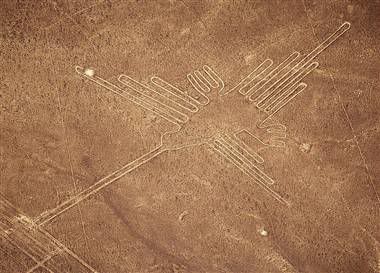
The latest threat to the vast U.N. World Heritage site, where enigmatic shapes and lines, stylized figures of birds and animals were etched in the desert 2,000 years ago, is a camp of around 30 shacks that appeared in August."
It's not much of a deterrent.

The latest threat to the vast U.N. World Heritage site, where enigmatic shapes and lines, stylized figures of birds and animals were etched in the desert 2,000 years ago, is a camp of around 30 shacks that appeared in August."
Navy Sued Over Harm to Whales From Mid-Frequency Sonar
"LOS ANGELES (October 19, 2005) -- Ear-splitting sonar used throughout the world's oceans during routine testing and training by the United States Navy harms marine mammals in violation of bedrock environmental laws, according to a lawsuit filed here today in federal court. Whales, dolphins and other marine animals could be spared excruciating injury and death with common sense precautions, but the Navy refuses to implement them, according to the lawsuit, brought by a coalition of conservation and animal welfare organizations led by the Natural Resources Defense Council (NRDC).
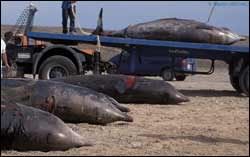
Mid-frequency sonar can emit continuous sound well above 235 decibels, an intensity roughly comparable to a Saturn V rocket at blastoff. Marine mammals have extraordinarily sensitive hearing, and there is no scientific dispute that intense sonar blasts can disturb, injure, and even kill them. Whales exposed to high-intensity mid-frequency sonar have repeatedly stranded and died on beaches around the world; some bleeding from the eyes and ears, with severe lesions in their organ tissue. At lower intensities, sonar can interfere with the ability of marine mammals to navigate, avoid predators, find food, care for their young, and, ultimately, to survive.
Mass stranding and mortality events associated with mid-frequency sonar exercises have occurred, among other places, in North Carolina (2005); Haro Strait off the coast of Washington State (2003); the Canary Islands (2004, 2002, 1989, 1986, 1985); Madeira (2000); the U.S. Virgin Islands (1999, 1998); and in Greece (1996). One of the best documented incidents occurred in the Bahamas in 2000 when 16 whales of three species stranded along 150 miles of shoreline as ships blasted the area with sonar. The U.S. Navy later acknowledged in an official report that its use of sonar was the likely cause of the stranding.
The association between sonar and whale mortalities is "very convincing and appears overwhelming," according to a report issued last year by the scientific committee of the International Whaling Commission, one of the world's leading bodies of whale biologists. The committee also noted concerns that stranding reports may underestimate sonar harm because they do not account for whales that die at sea and are never found."

Mid-frequency sonar can emit continuous sound well above 235 decibels, an intensity roughly comparable to a Saturn V rocket at blastoff. Marine mammals have extraordinarily sensitive hearing, and there is no scientific dispute that intense sonar blasts can disturb, injure, and even kill them. Whales exposed to high-intensity mid-frequency sonar have repeatedly stranded and died on beaches around the world; some bleeding from the eyes and ears, with severe lesions in their organ tissue. At lower intensities, sonar can interfere with the ability of marine mammals to navigate, avoid predators, find food, care for their young, and, ultimately, to survive.
Mass stranding and mortality events associated with mid-frequency sonar exercises have occurred, among other places, in North Carolina (2005); Haro Strait off the coast of Washington State (2003); the Canary Islands (2004, 2002, 1989, 1986, 1985); Madeira (2000); the U.S. Virgin Islands (1999, 1998); and in Greece (1996). One of the best documented incidents occurred in the Bahamas in 2000 when 16 whales of three species stranded along 150 miles of shoreline as ships blasted the area with sonar. The U.S. Navy later acknowledged in an official report that its use of sonar was the likely cause of the stranding.
The association between sonar and whale mortalities is "very convincing and appears overwhelming," according to a report issued last year by the scientific committee of the International Whaling Commission, one of the world's leading bodies of whale biologists. The committee also noted concerns that stranding reports may underestimate sonar harm because they do not account for whales that die at sea and are never found."
Tuesday, October 18, 2005
Tool-using gorillas intrigue scientists
It seems that scientists haven't kept up with the observed behavior of Koko, Michael and Ndume at Penny Patterson's Gorilla Foundation over the past 30 years, if they are surprised by gorilla tool use!
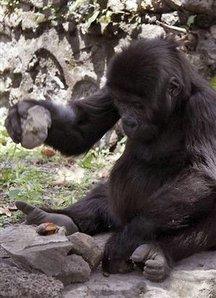
"GOMA, Congo - An infant gorilla in a Congo sanctuary is smashing palm nuts between two rocks to extract oil, surprising and intriguing scientists who say they have much to learn about what gorillas can do — and about the implications for evolution.It had been thought that the premeditated use of stones and sticks to accomplish a task like cracking nuts was restricted to humans and the smaller, more agile chimpanzees.
Then in late September, keepers at a Dian Fossey Gorilla Fund International sanctuary in this eastern Congo city saw 2 1/2-year-old female gorilla Itebero smashing palm nuts between rocks in the "hammer and anvil" technique, considered among the most complex tool use behaviors.
"This is a surprising finding, given what we know about tool use in gorillas," Patrick Mehlman, a primatologist for the Dian Fossey Gorilla Fund, said earlier this month at his Goma office."

"GOMA, Congo - An infant gorilla in a Congo sanctuary is smashing palm nuts between two rocks to extract oil, surprising and intriguing scientists who say they have much to learn about what gorillas can do — and about the implications for evolution.It had been thought that the premeditated use of stones and sticks to accomplish a task like cracking nuts was restricted to humans and the smaller, more agile chimpanzees.
Then in late September, keepers at a Dian Fossey Gorilla Fund International sanctuary in this eastern Congo city saw 2 1/2-year-old female gorilla Itebero smashing palm nuts between rocks in the "hammer and anvil" technique, considered among the most complex tool use behaviors.
"This is a surprising finding, given what we know about tool use in gorillas," Patrick Mehlman, a primatologist for the Dian Fossey Gorilla Fund, said earlier this month at his Goma office."

Labels:
ape,
gorilla,
intelligence
Saturday, October 15, 2005
A fountain pen for Gandhi: The story of a celebrated pen
"Great Indians ranging from Mahatma Gandhi to Indira Gandhi, Rajendra Prasad to Shankar Dayal Sharma, S. Kasturiranga Iyengar of The Hindu to Ramnath Goenka of Indian Express, had one thing in common: they used pens supplied from this town in coastal Andhra Pradesh. Ratnam pens, known as `swadeshi' pens, during the freedom movement, brought laurels to Rajahmundry and the pen-maker K.V. Ratnam.

The pen has many unique features. And you can order one of your choice.
During the swadeshi movement, after Gandhiji gave a call to boycott foreign goods, Ratnam, who was until then involved in making lithographic blocks, met Gandhiji in 1921. Gandhiji advised him to make something that would be useful to the common man and that was inexpensive.
Ratnam and his brother, basically goldsmiths, made a golden nib and presented it to a sub-judge who needed it. Then in 1932, Nyapati Subba Rao Pantulu, one of the founders of The Hindu, ordered the first pen. It was made of silver.
Nyapati Subba Rao (Junior), a grandson of Subba Rao Pantulu, said: 'It is true that the first pen was purchased by my grandfather. He used only Ratnam pens. They were made to order and gifted to VIPs visiting Rajahmundry. I was told that my grandfather personally delivered Ratnam pens to Sri Kasturiranga Iyengar several times.'
One for Gandhiji
Ratnam made a pen made in ebonite material and sent it to Gandhiji, who wrote to him commending it. Gandhiji wrote from Wardha: 'Dear Ratnam, I must thank you for the fountain pen you sent me... I have needed it and [it] seems to be a good substitute to the foreign pen, once in the bazaar. Yours sincerely, M.K. Gandhi, 16.7.1935. '
The pens retained their popularity after Independence and remained status symbols. In the 1950s, a Ratnam golden pen (22 carat gold) cost Rs.55: now it costs Rs.30, 000. Prices now range from Rs.35 to Rs.40,000.
K.V. Narasimhacharyulu and K.V. Ramana, Ratnam's two sons, assisted their father in the business. In 1959, Mr. Narasimhacharyulu went to Germany and on his return started a ballpoint pen manufacturing unit, for the first time in India in Rajahmundry. The brothers run the pen business today.
A Ratnam pen takes at least two days to deliver — custom-made, to individual taste."

The pen has many unique features. And you can order one of your choice.
During the swadeshi movement, after Gandhiji gave a call to boycott foreign goods, Ratnam, who was until then involved in making lithographic blocks, met Gandhiji in 1921. Gandhiji advised him to make something that would be useful to the common man and that was inexpensive.
Ratnam and his brother, basically goldsmiths, made a golden nib and presented it to a sub-judge who needed it. Then in 1932, Nyapati Subba Rao Pantulu, one of the founders of The Hindu, ordered the first pen. It was made of silver.
Nyapati Subba Rao (Junior), a grandson of Subba Rao Pantulu, said: 'It is true that the first pen was purchased by my grandfather. He used only Ratnam pens. They were made to order and gifted to VIPs visiting Rajahmundry. I was told that my grandfather personally delivered Ratnam pens to Sri Kasturiranga Iyengar several times.'
One for Gandhiji
Ratnam made a pen made in ebonite material and sent it to Gandhiji, who wrote to him commending it. Gandhiji wrote from Wardha: 'Dear Ratnam, I must thank you for the fountain pen you sent me... I have needed it and [it] seems to be a good substitute to the foreign pen, once in the bazaar. Yours sincerely, M.K. Gandhi, 16.7.1935. '
The pens retained their popularity after Independence and remained status symbols. In the 1950s, a Ratnam golden pen (22 carat gold) cost Rs.55: now it costs Rs.30, 000. Prices now range from Rs.35 to Rs.40,000.
K.V. Narasimhacharyulu and K.V. Ramana, Ratnam's two sons, assisted their father in the business. In 1959, Mr. Narasimhacharyulu went to Germany and on his return started a ballpoint pen manufacturing unit, for the first time in India in Rajahmundry. The brothers run the pen business today.
A Ratnam pen takes at least two days to deliver — custom-made, to individual taste."
The world's first biplanes were ... dinosaurs?
"Like the Wright brothers, the first flying dinosaurs took to the air with two sets of wings.
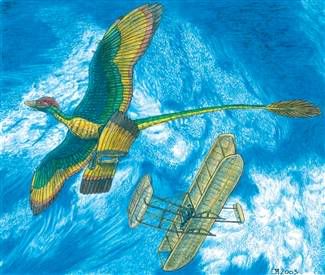
New analysis of the winged Microraptor gui suggests that the first feathered dinos relied on a biplane-like wing configuration to swoop from tree to tree. The result may settle a century-old controversy over how the first feathered creatures achieved flight.
"It is intriguing to contemplate that perhaps avian flight, like aircraft evolution, went through a biplane stage before the monoplane was introduced," said Sankar Chatterjee of Texas Tech University. "It seems likely that Microraptor invented the biplane 125 million years before the Wright 1903 Flyer.""

New analysis of the winged Microraptor gui suggests that the first feathered dinos relied on a biplane-like wing configuration to swoop from tree to tree. The result may settle a century-old controversy over how the first feathered creatures achieved flight.
"It is intriguing to contemplate that perhaps avian flight, like aircraft evolution, went through a biplane stage before the monoplane was introduced," said Sankar Chatterjee of Texas Tech University. "It seems likely that Microraptor invented the biplane 125 million years before the Wright 1903 Flyer.""
Friday, October 14, 2005
Chinese astronauts complete 3rd day in space
"Ships tracking China's Shenzhou 6 spacecraft encountered rough weather Friday and were preparing emergency measures in case conditions worsened, even as the astronauts completed their third day in orbit without a hitch, state media reported.
The four ships monitoring the spacecraft's position from posts in the Pacific, Indian and Atlantic oceans were fighting high winds and waves late Friday, the official Xinhua News Agency said.
Up in space, the capsule performed a delicate operation to adjust its orbit earlier in the day, and its two astronauts were well-rested and in good health, China Central Television said."
The four ships monitoring the spacecraft's position from posts in the Pacific, Indian and Atlantic oceans were fighting high winds and waves late Friday, the official Xinhua News Agency said.
Up in space, the capsule performed a delicate operation to adjust its orbit earlier in the day, and its two astronauts were well-rested and in good health, China Central Television said."
The king and I
"The World Chess Championship, San Luis, Argentina: what an event! The daily hecatombs of pieces and pawns have produced the most thrilling chess spectacle of recent decades. It is a pity there are so few visitors to the hall to witness the bloodbath. Never mind: the servers that carry the moves live around the globe are breaking all audience records.
One man, Bulgaria's Veselin Topalov, has given an exhibition of such virtuosity that it looks doubtful, at the halfway stage, that he can be stopped. The comparisons are not with Garry Kasparov - merely the greatest chess player ever - but with Bobby Fischer, the only modern giant capable of such thorough annihilation. Of course the 30-year-old could still falter: when the crown is within touching distance, strange things happen to all but the most steely-nerved."
One man, Bulgaria's Veselin Topalov, has given an exhibition of such virtuosity that it looks doubtful, at the halfway stage, that he can be stopped. The comparisons are not with Garry Kasparov - merely the greatest chess player ever - but with Bobby Fischer, the only modern giant capable of such thorough annihilation. Of course the 30-year-old could still falter: when the crown is within touching distance, strange things happen to all but the most steely-nerved."
Bobby Fischer Wants to Face Bulgaria's Topalov
"The legendary Bobby Fischer is willing to play against Bulgaria's chess master Vesselin Topalov, local Trud daily reported.
The newspaper cites an Australian reporter covering the World Chess Championship in San Luis. The reporter claims that Fischer is willing to face Topalov in a game of chess, but not the classical type of the game but a version invented by Fischer.
The Australian reporter has informed the manager of the Bulgarian chess master and says that he is preparing the game, Trud daily says."
The newspaper cites an Australian reporter covering the World Chess Championship in San Luis. The reporter claims that Fischer is willing to face Topalov in a game of chess, but not the classical type of the game but a version invented by Fischer.
The Australian reporter has informed the manager of the Bulgarian chess master and says that he is preparing the game, Trud daily says."
Thursday, October 13, 2005
Wednesday, October 12, 2005
Birdlike dinosaur may force raptor revisions
"The discovery of a birdlike dinosaur in South America has paleontologists rethinking when, where and how one group of raptors evolved.

The rooster-sized dinosaur is called Buitreraptor (bwee-tree-rap-tor) gonzalezorum. It has a long head and long tail and winglike forelimbs. Its serrated teeth, shaped like steak knives, suggest it was a carnivore.
Buitreraptor is related to Velociraptor, the presumably cunning killer made famous by Hollywood. Both belong to a class of birdlike dinosaurs that ran swiftly on two legs and are called dromaeosaurs."

The rooster-sized dinosaur is called Buitreraptor (bwee-tree-rap-tor) gonzalezorum. It has a long head and long tail and winglike forelimbs. Its serrated teeth, shaped like steak knives, suggest it was a carnivore.
Buitreraptor is related to Velociraptor, the presumably cunning killer made famous by Hollywood. Both belong to a class of birdlike dinosaurs that ran swiftly on two legs and are called dromaeosaurs."
Labels:
birds
Tuesday, October 11, 2005
More bones of hobbit-sized humans discovered - Science - MSNBC.com
"Scientists digging in a remote Indonesian cave have uncovered a jawbone that they say adds more evidence that a tiny prehistoric Hobbit-like species once existed.
The jaw is from the ninth individual believed to have lived as recently as 12,000 years ago. The bones are in a wet cave on the island of Flores in the eastern limb of the Indonesian archipelago, near Australia.
The research team which reported the original sensational finding nearly a year ago strongly believes that the skeletons belong to a separate species of early human that shared Earth with modern humans far more recently than anyone thought."
The jaw is from the ninth individual believed to have lived as recently as 12,000 years ago. The bones are in a wet cave on the island of Flores in the eastern limb of the Indonesian archipelago, near Australia.
The research team which reported the original sensational finding nearly a year ago strongly believes that the skeletons belong to a separate species of early human that shared Earth with modern humans far more recently than anyone thought."
Labels:
floresiensis. flores,
hobbit
Thursday, October 06, 2005
The World's Smallest Fountain Pen
"Researchers have created the world's smallest fountain pen with a tip so tiny it can draw lines a hundred times thinner than a red blood cell.
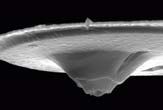
Called the 'nanonfountain probe,' it can paint lines as thin as 40 nanometers and has its own reservoir to hold various types of inks, including pigments for painting patterns and organic materials for designing sensors.
Existing nano-pens use the same type of inks, but cannot hold an ink supply and must be dipped into the ink."

Called the 'nanonfountain probe,' it can paint lines as thin as 40 nanometers and has its own reservoir to hold various types of inks, including pigments for painting patterns and organic materials for designing sensors.
Existing nano-pens use the same type of inks, but cannot hold an ink supply and must be dipped into the ink."
Labels:
pens
Monday, October 03, 2005
'Planet Xena' has a sidekick -- Gabrielle
"The astronomers who claim to have discovered the 10th planet in the Earth's solar system have made another intriguing announcement: it has a moon.
The moon discovery is important because it can help scientists determine the new planet's mass. In July, Brown announced the discovery of an icy, rocky object larger than Pluto in the Kuiper Belt, a disc of icy bodies beyond Neptune. Brown labeled the object a planet and nicknamed it Xena after the lead character in the former TV series "Xena: Warrior Princess."
By determining the moon's distance and orbit around Xena, scientists can calculate how heavy Xena is. For example, the faster a moon goes around a planet, the more massive a planet is.
But the newly discovered moon, nicknamed Gabrielle after Xena's faithful traveling sidekick in the TV series, likely will not quell the debate over what exactly is a planet and whether Pluto should keep its status. The problem is there is no official definition for a planet and setting standards like size limits potentially invites other objects to take the "planet" label."
The moon discovery is important because it can help scientists determine the new planet's mass. In July, Brown announced the discovery of an icy, rocky object larger than Pluto in the Kuiper Belt, a disc of icy bodies beyond Neptune. Brown labeled the object a planet and nicknamed it Xena after the lead character in the former TV series "Xena: Warrior Princess."
By determining the moon's distance and orbit around Xena, scientists can calculate how heavy Xena is. For example, the faster a moon goes around a planet, the more massive a planet is.
But the newly discovered moon, nicknamed Gabrielle after Xena's faithful traveling sidekick in the TV series, likely will not quell the debate over what exactly is a planet and whether Pluto should keep its status. The problem is there is no official definition for a planet and setting standards like size limits potentially invites other objects to take the "planet" label."
Subscribe to:
Posts (Atom)




